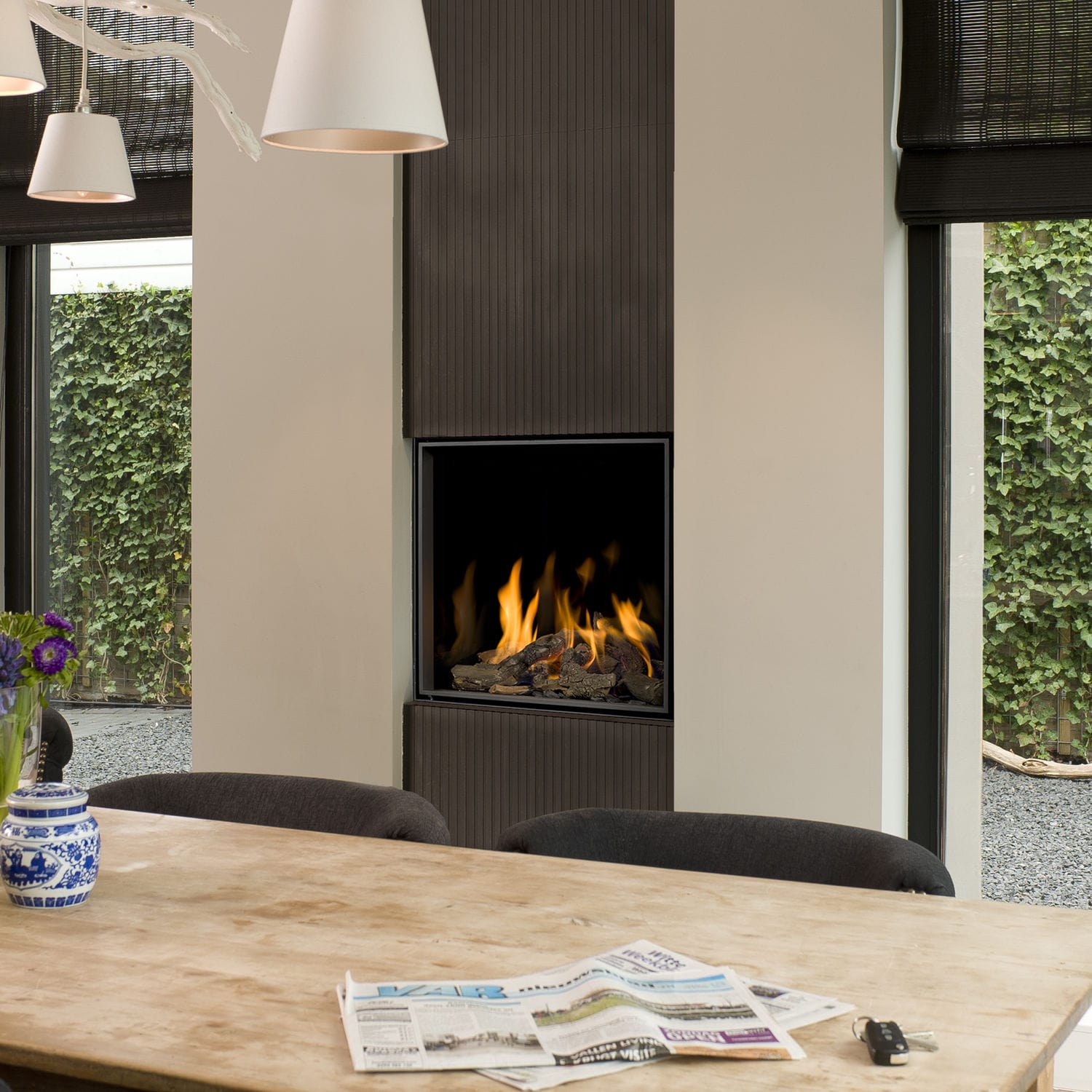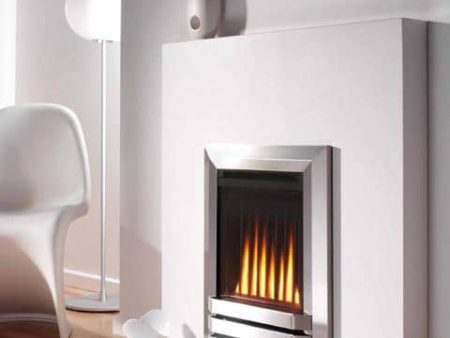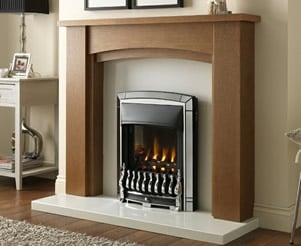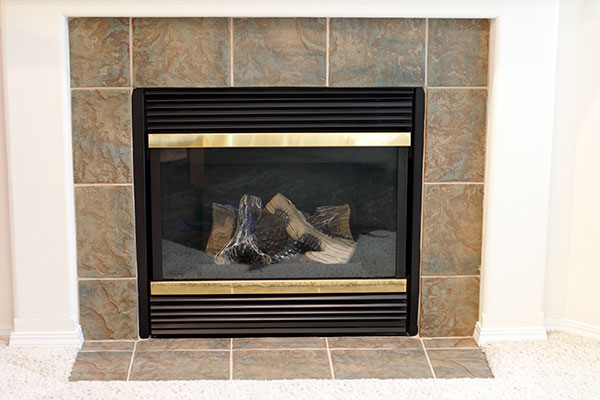Gas Fireplaces – An Overview
Gas fireplaces have become a popular choice among homeowners for their convenience, efficiency, and aesthetic appeal. Unlike traditional wood-burning fireplaces, gas fireplaces provide a clean and easily controllable heat source. They offer the charm of a real flame without the hassle of chopping wood, dealing with ashes, or managing creosote buildup.
A key advantage of gas fireplaces is their ease of use. With the flip of a switch or the push of a button, you can instantly enjoy a warm and inviting fire. Many models come with remote controls and programmable thermostats, allowing for precise control over the flame intensity and heat output. This convenience makes gas fireplaces an attractive option for those seeking both comfort and efficiency.
Gas fireplaces are also known for their efficiency. They convert a high percentage of the fuel they consume into heat, making them an effective way to warm your home. This efficiency translates into cost savings on your energy bills, especially during the colder months. Additionally, gas fireplaces produce fewer emissions compared to wood-burning fireplaces, contributing to a cleaner environment.

Another benefit is the aesthetic versatility of gas fireplaces. They come in various styles and designs, from traditional to contemporary, allowing you to choose a model that complements your home’s decor. Gas fireplaces can be installed in different locations, including living rooms, bedrooms, and even outdoor spaces, providing a focal point and enhancing the ambiance of any room.
Safety is a significant factor when considering a gas fireplace. These fireplaces are equipped with various safety features, such as automatic shut-off valves and oxygen depletion sensors, to prevent accidents. Unlike wood-burning fireplaces, gas fireplaces do not produce sparks or embers that could pose a fire hazard. Proper installation and regular maintenance are crucial to ensuring safe operation.
Gas fireplaces also offer the advantage of flexibility in fuel options. They can be powered by natural gas or propane, depending on availability and preference. Natural gas is typically more cost-effective and provides a continuous supply, while propane is a good option for homes without access to natural gas lines. This flexibility allows homeowners to choose the best fuel source for their needs and location.

The Role of the Flue
The flue is a critical component of any fireplace, including gas fireplaces. Its primary function is to provide a safe pathway for exhaust gases to escape from the fireplace to the outside of the home. This prevents the buildup of harmful gases, such as carbon monoxide, inside the living space, ensuring the safety and health of the occupants.
In a gas fireplace, the flue plays a similar role to that in a wood-burning fireplace, though the nature of the exhaust gases is different. Gas fireplaces produce combustion byproducts that include carbon dioxide, water vapor, and small amounts of carbon monoxide. The flue system must effectively vent these gases to maintain air quality and prevent potential hazards.
There are two main types of flue systems used in gas fireplaces: direct vent and vent-free. Direct vent systems draw air from outside the home for combustion and expel exhaust gases back outside. This sealed system is highly efficient and reduces the risk of indoor air pollution. Vent-free systems, on the other hand, do not use a flue and are designed to burn gas so cleanly that no venting is required. However, vent-free systems are subject to strict regulations and are not permitted in some areas due to potential indoor air quality concerns.

The flue must be appropriately sized and installed to ensure proper ventilation. An undersized flue can lead to an inadequate draft, causing exhaust gases to spill back into the home. Conversely, an oversized flue can reduce the efficiency of the fireplace by allowing too much heat to escape. Professional installation and regular inspection of the flue system are essential to maintaining its effectiveness.
Regular maintenance of the flue is crucial for safety and performance. Over time, the flue can accumulate soot, debris, or even blockages from animal nests. These obstructions can hinder the proper venting of exhaust gases, leading to potential hazards. Annual inspections by a qualified technician can identify and address any issues with the flue, ensuring it operates safely and efficiently.
Understanding the role of the flue in a gas fireplace underscores the importance of proper installation, maintenance, and use. By ensuring that the flue is functioning correctly, homeowners can enjoy the benefits of their gas fireplace while maintaining a safe and healthy indoor environment.

Interesting Articles You May Want to Check:
- DIY Outdoor Gas Fireplace Kits
- Turn on a Gas Fireplace
- Emberglow Vent Free Gas Fireplace
- How To Remove Gas Fireplace Glass
- Gas Fireplace Exhaust

Importance of Keeping the Flue Open
Keeping the flue open in a gas fireplace is essential for safe operation. When the flue is open, it allows exhaust gases, such as carbon monoxide, to escape safely from the fireplace to the outside of the home. This prevents the buildup of harmful gases indoors, which can pose serious health risks to the occupants.
One of the primary dangers of operating a gas fireplace with the flue closed is carbon monoxide poisoning. Carbon monoxide is a colorless, odorless gas that can be deadly at high concentrations. Symptoms of carbon monoxide poisoning include headaches, dizziness, nausea, and in severe cases, loss of consciousness or death. Ensuring that the flue is open and functioning correctly helps prevent the accumulation of this dangerous gas.
In addition to carbon monoxide, other combustion byproducts, such as carbon dioxide and water vapor, need to be vented out through the flue. These gases can contribute to poor indoor air quality if not properly exhausted. An open flue allows these byproducts to exit the home, maintaining a healthier living environment.

An open flue also plays a role in maintaining the efficiency of the gas fireplace. Proper ventilation ensures that the fireplace operates as designed, providing optimal heat output and fuel efficiency. A closed or obstructed flue can disrupt the airflow, leading to reduced performance and potentially higher fuel consumption.
Moreover, keeping the flue open reduces the risk of damage to the fireplace and the home. Exhaust gases can corrode metal components and cause moisture damage if they are not properly vented. Over time, this can lead to costly repairs or even the need to replace the fireplace. Ensuring that the flue is open and clear of obstructions helps protect the longevity and integrity of the fireplace.
Regularly checking the flue before operating the gas fireplace is a simple yet crucial step in ensuring safe use. Homeowners should make it a habit to verify that the flue is open and unobstructed each time they use the fireplace. Installing carbon monoxide detectors in the home is also a wise precaution, providing an additional layer of safety and early warning in case of any issues.

Identifying a Closed Flue
Identifying whether the flue is closed or open is critical for the safe operation of a gas fireplace. Homeowners should be familiar with their fireplace system and know how to check the flue’s position before lighting a fire. There are several methods and signs to help determine if the flue is closed.
One of the most straightforward methods is to visually inspect the flue damper. The damper is the mechanism that controls the flue’s opening and closing. In many fireplaces, the damper is located near the top of the firebox or along the chimney. When the damper is open, it should be positioned parallel to the flue, allowing gases to escape. When it is closed, the damper will be perpendicular to the flue, blocking the passage. Checking the damper’s position can provide a clear indication of whether the flue is open or closed.
Another method is to feel for airflow. When the fireplace is not in use, place your hand near the flue opening. If you feel a draft or cool air moving, it typically means the flue is open, allowing outside air to flow into the chimney. If there is no airflow, the flue may be closed. This method can be particularly useful for fireplaces with hard-to-see damper mechanisms.
Listening to sounds can also help determine the flue’s status. When the flue is open, you may hear outside noises, such as wind or birds, coming through the chimney. A closed flue will muffle these sounds, indicating that the damper is blocking the passage. While not as reliable as visual inspection, listening can provide additional clues about the flue’s position.
Some gas fireplaces come equipped with indicator mechanisms or sensors that show the flue’s status. These indicators can be simple levers or more sophisticated electronic displays that signal whether the flue is open or closed. Familiarizing yourself with these indicators can make it easier to check the flue before using the fireplace.
Professional inspection and maintenance are essential for ensuring the flue is functioning correctly. Annual inspections by a qualified technician can identify any issues with the flue, damper, or other components of the fireplace system. During these inspections, the technician can verify the flue’s operation, clean any obstructions, and make necessary repairs.
Homeowners should develop a routine of checking the flue each time they use the fireplace. Making this a habit ensures that the flue is always open when the fireplace is in operation, reducing the risk of dangerous gas buildup and ensuring safe and efficient use.

Consequences of Operating with a Closed Flue
Operating a gas fireplace with a closed flue can have serious consequences, both in terms of safety and the integrity of the fireplace system. Understanding these risks underscores the importance of ensuring the flue is open and functioning properly before use.
One of the most significant dangers of a closed flue is the risk of carbon monoxide poisoning. Carbon monoxide (CO) is a toxic gas produced by the incomplete combustion of natural gas or propane. When the flue is closed, CO cannot escape to the outside, leading to a buildup of this dangerous gas within the home. Prolonged exposure to high levels of carbon monoxide can cause symptoms such as headaches, dizziness, nausea, and even death. This risk highlights the critical need for proper ventilation when operating a gas fireplace.
In addition to carbon monoxide, other combustion byproducts such as carbon dioxide and water vapor can accumulate with a closed flue. These gases can contribute to poor indoor air quality and respiratory issues for the occupants. Over time, the buildup of moisture from water vapor can also lead to mold growth and structural damage to the home, compounding the health and safety risks.
A closed flue can also impair the performance and efficiency of the gas fireplace. Without proper ventilation, the fireplace cannot operate at its designed efficiency, leading to reduced heat output and increased fuel consumption. This inefficiency not only results in higher energy costs but also diminishes the comfort and benefits that a gas fireplace is supposed to provide.
The integrity and longevity of the fireplace system can be compromised by operating with a closed flue. Combustion byproducts that are not properly vented can cause corrosion and damage to the fireplace components, including the burner, ignition system, and internal metal parts. Over time, this damage can lead to costly repairs or the need for complete replacement of the fireplace unit.
Fire hazards are another potential consequence of a closed flue. The buildup of unvented gases can create a dangerous situation where a spark or ignition source could cause an explosion or fire. Ensuring the flue is open and unobstructed is a key measure in preventing such catastrophic events.
Regular inspections and maintenance are essential to prevent these consequences. Homeowners should schedule annual inspections with a qualified technician to check the flue, damper, and other components of the fireplace system. These inspections can identify any issues and ensure that the fireplace is safe and ready for use.

Maintaining and Inspecting the Flue
Regular maintenance and inspection of the flue are vital for the safe and efficient operation of a gas fireplace. These practices help identify potential issues before they become serious problems and ensure that the fireplace system functions correctly.
Annual inspections by a professional technician are recommended. During these inspections, the technician will check the flue, damper, and other components of the fireplace system. They will look for signs of wear, corrosion, or damage and clean any accumulated soot or debris. This thorough inspection helps ensure that the flue is clear and functioning properly, reducing the risk of dangerous gas buildup.
Homeowners should also perform routine checks between professional inspections. Before using the fireplace, it is important to verify that the flue is open and unobstructed. This can be done by visually inspecting the damper, feeling for airflow, and listening for outside noises coming through the chimney. Regular checks help maintain safe operation and can prevent potential hazards.
Cleaning the flue and chimney is an essential part of maintenance. Over time, soot and other residues can build up inside the flue, reducing its effectiveness and increasing the risk of blockages. A professional chimney sweep can clean the flue, removing any debris and ensuring a clear pathway for exhaust gases. This cleaning should be done annually or more frequently if the fireplace is used regularly.
In addition to the flue, the damper should be inspected and maintained. The damper is the mechanism that controls the opening and closing of the flue. It should move smoothly and seal properly when closed. Any signs of rust, corrosion, or difficulty in operation should be addressed by a professional. Proper damper maintenance ensures that the flue can be easily opened and closed as needed.
Installing carbon monoxide detectors in the home is a crucial safety measure. These detectors provide an early warning if carbon monoxide levels become dangerous, allowing occupants to take immediate action. Detectors should be placed near the fireplace and in other areas of the home, such as bedrooms, to ensure comprehensive monitoring.
Keeping a maintenance log can help track inspections, cleanings, and any repairs performed on the fireplace system. This log provides a record of when maintenance tasks were completed and can be useful for scheduling future inspections and addressing any recurring issues. Regular maintenance and inspection are key to the safe and efficient operation of a gas fireplace, ensuring that the flue and other components remain in good condition.

Common Mistakes to Avoid
Avoiding common mistakes when operating and maintaining a gas fireplace can help ensure its safe and efficient use. Being aware of these pitfalls can prevent potential hazards and costly repairs.
One common mistake is neglecting to check the flue before using the fireplace. Failing to verify that the flue is open can result in dangerous gas buildup and an increased risk of carbon monoxide poisoning. Homeowners should make it a habit to check the flue’s position every time they use the fireplace, ensuring it is open and unobstructed.
Using the wrong type of fuel is another frequent issue. Gas fireplaces are designed to burn either natural gas or propane and using an incorrect or incompatible fuel can damage the fireplace and pose safety risks. It’s essential to use the fuel type specified by the manufacturer and ensure that the fuel supply is properly connected and regulated.
Improper installation of the flue or damper can lead to inadequate ventilation and reduced efficiency. Professional installation by a qualified technician is crucial to ensure that all components are correctly fitted and function as intended. Attempting to install or modify the fireplace system without professional assistance can result in serious problems and void warranties.
Neglecting regular maintenance and inspections is a common mistake that can compromise the fireplace’s performance and safety. Annual inspections and routine cleanings are essential to keep the flue, damper, and other components in good condition. Ignoring these maintenance tasks can lead to blockages, corrosion, and other issues that affect the fireplace’s operation.
Blocking the airflow around the fireplace can also cause problems. Gas fireplaces need proper ventilation to operate efficiently and safely. Placing furniture, decorations, or other items too close to the fireplace can restrict airflow and increase the risk of overheating or fire hazards. It’s important to maintain clearances recommended by the manufacturer and ensure adequate ventilation.
Finally, ignoring signs of trouble can lead to more significant issues. Unusual noises, odors, or changes in flame appearance can indicate problems with the fireplace or flue system. Addressing these signs promptly by contacting a professional technician can prevent minor issues from becoming major repairs and ensure the fireplace continues to operate safely.

Why is it important to keep the flue open in a gas fireplace?
Keeping the flue open in a gas fireplace is crucial for safely venting combustion byproducts, including carbon monoxide, to the outside of the home. An open flue ensures that these harmful gases do not accumulate indoors, protecting the health and safety of the occupants. Proper ventilation also maintains the fireplace’s efficiency and prevents potential damage to the fireplace system and home.
How can I tell if my gas fireplace flue is closed?
You can determine if your gas fireplace flue is closed by visually inspecting the damper, feeling for airflow, and listening for outside noises through the chimney. The damper should be positioned parallel to the flue when open and perpendicular when closed. Feeling for airflow or listening for outdoor sounds can also indicate the flue’s status. Some fireplaces have indicators or sensors that show whether the flue is open or closed.
What are the risks of operating a gas fireplace with a closed flue?
Operating a gas fireplace with a closed flue can lead to the buildup of dangerous gases, such as carbon monoxide, inside the home. This can cause serious health risks, including carbon monoxide poisoning, which can be fatal. A closed flue also reduces the fireplace’s efficiency, increases the risk of damage to the fireplace system, and can pose fire hazards due to unvented gases.
How often should the flue in a gas fireplace be inspected?
The flue in a gas fireplace should be inspected annually by a professional technician. Regular inspections help ensure that the flue is clear of obstructions, properly functioning, and safe to use. Homeowners should also perform routine checks before each use to verify that the flue is open and unobstructed.
Can I use a gas fireplace if the flue is partially closed?
Using a gas fireplace with a partially closed flue is not recommended. A partially closed flue can restrict the proper venting of combustion byproducts, leading to poor indoor air quality and an increased risk of carbon monoxide buildup. For safe operation, the flue should be fully open to ensure adequate ventilation and prevent potential hazards.
What should I do if I suspect my gas fireplace flue is blocked?
If you suspect your gas fireplace flue is blocked, you should immediately stop using the fireplace and contact a professional technician for inspection and cleaning. A blocked flue can prevent proper ventilation, leading to dangerous gas buildup and reduced fireplace performance. Professional inspection and cleaning will ensure the flue is clear and safe to use. Installing carbon monoxide detectors can also provide an early warning of any issues.

Related Posts: